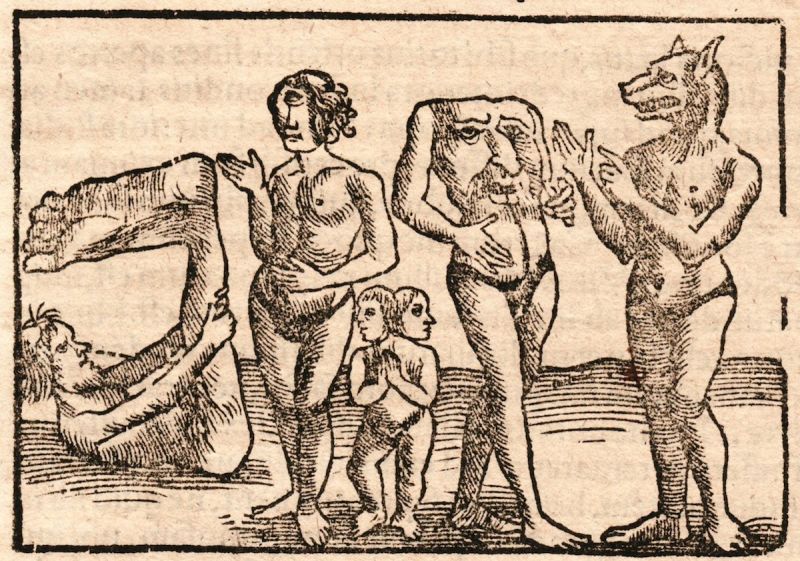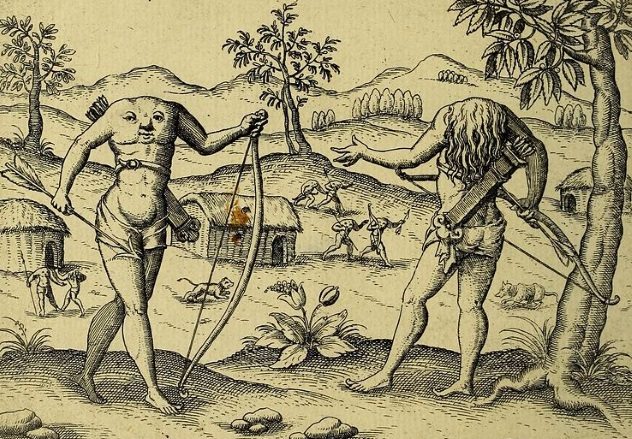Ancient Psychedelia: Alien Gods & Mushroom Goddesses
Online Book - Chapter 11, Page 222
Back to Online Book Mainpage / Next Page (Chapter 11, Page 223)
| Monopods and Anguipedes Monopods (also sciapods, skiapods, skiapodes) are mythological dwarf-like creatures with a single, large foot extending from a leg centered in the middle of their bodies. The names monopod and skiapod are both Greek, respectively meaning "one-foot" and “shadow-foot.” In Pliny’s Natural History, which I advise against taking too seriously as far as “accurate history” is concerned, we read about “The Wondrous Forms of Different Nations,” in Chapter 2, where he is quoting many different “authorities” on the many people who inhabit the world: “He speaks also of another race of men, who are known as Monocoli, who have only one leg, but are able to leap with surprising agility. The same people are also called Sciapodæ; because they are in the habit of lying on their backs, during the time of the extreme heat, and protect themselves from the sun by the shade of their feet. These people, he says, dwell not very far from the Troglodytæ; to the west of whom again there is a tribe who are without necks, and have eyes in their shoulders.” This is a great description of a mythical people, but not “natural history” by any means. Earlier in the chapter before he gets here, he discusses the Cyclops and beings who eat people and commit human sacrifice: “We have already stated, that there are certain tribes of the Scythians, and, indeed, many other nations, which feed upon human flesh. This fact itself might, perhaps, appear incredible, did we not recollect, that in the very centre of the earth, in Italy and Sicily, nations formerly existed with these monstrous propensities, the Cyclopes, and the Læstrygones, for example; and that, very recently, on the other side of the Alps, it was the custom to offer human sacrifices, after the manner of those nations; and the difference is but small between sacrificing human beings and eating them.” Continuing from Natural History: “In the vicinity also of those who dwell in the northern regions, and not far from the spot from which the north wind arises, and the place which is called its cave, and is known by the name of Geskleithron, the Arimaspi are said to exist, whom I have previously mentioned, a nation remarkable for having but one eye, and that placed in the middle of the forehead. This race is said to carry on a perpetual warfare with the Griffins, a kind of monster, with wings, as they are commonly represented, for the gold which they dig out of the mines, and which these wild beasts retain and keep watch over with a singular degree of cupidity, while the Arimaspi are equally desirous to get possession of it. Many authors have stated to this effect, among the most illustrious of whom are Herodotus and Aristeas of Proconnesus.” (266) Once again, we are reminded in this story, of the dragons guarding a sacred treasure. According to Peter Lambert Wilson, in Ploughing the Clouds, we hear about the shadefoots from Scylax in the 6th century BC, who, according to Herodotus (4.44), wrote a description of a trip down the Indus during the reign of King Darius I. Unfortunately, nothing remains of Scylax’s book, so we have a book by Ctesias, a Greek physician from Cnidos who served at the Persian court and wrote an account of a similar voyage. Both travelers claimed India was the homeland to the shade-foots. (267) Carl Ruck has brought up a Libyan origin for the shadefoots. (268) |
Some of the depictions of the shadefoots or monopedes include an engraving from the manuscript of Marco Polo’s travels from 1544, showing (from left to right) a monopod or sciapod, a female cyclops, conjoined twins, a blemmye, and a cynocephali (72e). An image from the Medieval Bestiaries (72f). A Sciapod protecting himself from the sun by the shade of his foot in margin of “Heures à l’usage des Antonins,” c. 1400-1500 (72g), an image from 1275-1300 (72h), and finally, a depiction of Xing Tian, as a blemmye (72i). The Irish Fomorians, who we will soon arrive at in our study, were also said to have one eye, one arm and one leg. (72e) Engraving showing (from left to right) a monopod or sciapod, a female cyclops, conjoined twins, a blemmye, and a cynocephali, Manuscript of Marco Polo’s travels. c. 1544 AD  (72f) Medieval Bestiary Figures (266) Pliny, Natural History VII, Chapter 2 (267) Ploughing the Clouds, The Search for Irish Soma, Peter Lamborn Wilson, City Lights Books, 1999, p. 21-22 (268) Persephone’s Quest, p. 152 |
Go Back to Page 221